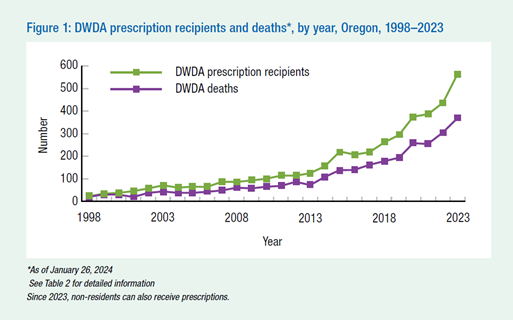THE latest US government report on assisted suicide in Oregon has revealed that rates have increased by 20 per cent in the last year alone.
The official statistics also provide startling new evidence of botched assisted suicides, where instead of ‘dying with dignity’ one patient took a record five days to expire after ingesting a lethal cocktail.
The surge in the numbers of cases adds to the huge volume of evidence of a ‘slippery slope’ in every jurisdiction which has changed its laws to allow assisted suicide or euthanasia.
The figures were released in the UK by the Oxford-based Anscombe Bioethics Centre, a respected bioethics institute serving the Catholic Church in the UK and Ireland. They come weeks after Belgium announced a 15 per cent surge in euthanasia deaths and a doubling of cases in just a decade, putting deaths by lethal injections there at a record high.
This is the Anscombe Bioethics press release:
In 1997, Oregon became the first jurisdiction to legalise physician-assisted suicide for people with a terminally illness. Since then numbers have increased year-on-year and this shows no sign of slowing.
This week, Oregon produced its twenty-sixth report. This shows that 2023 saw a 20 per cent increase in assisted suicide compared to 2022, which itself had been a record-breaking year.

Last year, at least 367 people died by assisted suicide, an average of one a day. This would be equivalent to 15 assisted suicides per day in a population the size of the United Kingdom.
Not all these deaths were quick or easy. In 159 cases, death was motivated by a fear of being a burden on family, friends or care givers. In 28 cases, death occurred without the presence or even the knowledge of a loved one. Complications such as seizures or vomiting occurred in around 10 per cent of cases and this does not include lingering deaths. As Oregon continues to experiment with different cocktails of lethal drugs, median times to death have increased (from 22 minutes in 1998 to 52 minutes in 2023). One patient in 2023 took more than five days to die. If this had been an execution, it would have been cruel or unusual punishment.
The law is supposed to be restricted to people who would otherwise die of natural causes within six months, but in 2023 it was provided to 17 people who had outlived their six-month prognosis. One patient had lived four and a half years since being approved for assisted suicide. These were people who had decided to delay taking the lethal drugs. For the majority, who took the drugs within four weeks of requesting them, we have no way of knowing how many more months or years they otherwise could have lived.
While Oregon continues to break records for numbers of assisted suicides, numbers who did not inform their families, and numbers and length of lingering deaths by assisted suicide, its rate of non-assisted suicide also continues to climb. Statistics from the Centers of Disease Control and Prevention show that between 2005 and 2021 the (‘non-assisted’) suicide rate in Oregon increased from 14.9 per 100,000 to 19.5 per 100,000. For comparison, the suicide rate in England and Wales in 2021 was 10.7 per 100,000.
Research published in 2022 demonstrated that, in the United States, legalising physician-assisted suicide had been associated with a 6 per cent increase in the suicide rate, with a 14 per cent increase among women. These results were statistically significant even after controlling for socio-demographic factors. Legalisation of euthanasia or assisted suicide is a threat to suicide prevention.
In England and Wales, it is illegal to encourage or assist suicide. The current law helps prevent suicide and helps protect vulnerable people. The example of Oregon this year, as in the past 25 years, continues to provide a warning of what can happen if this protection is removed.

